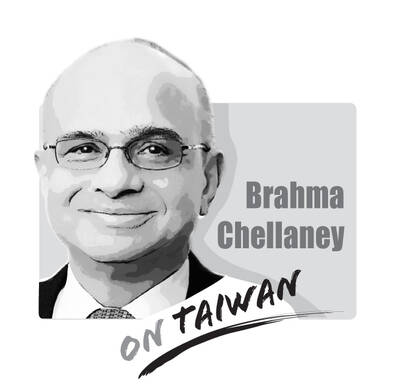For the past few decades, global warming and extreme weather have posed an increasing threat to the Earth’s ecology and human civilization.
Having drawn worldwide attention to the climate crisis, the 26th UN Climate Change Conference of the Parties (COP26) culminated in the Glasgow Climate Pact.
In the agreement, nearly 200 countries committed to cutting carbon dioxide emissions by 45 percent by 2030 and to achieve net-zero carbon emissions by 2050.
In the opening speech of the “Sustainability: Solutions for Our Earth” forum on Earth Day, April 22, President Tsai Ing-wen (蔡英文) said: “Most countries around the world are talking about achieving net-zero carbon emissions by 2050, and Taiwan is actively preparing to take steps toward this goal.”
With the support of the Ministry of Science and Technology, National Tsing Hua University and the Chang Chun Group have since 2014 invested NT$700 million (US$25.28 million) to advance the research and innovation needed to achieve net-zero emissions.
Under the supervision of program director and chemical engineering professor Jang Shi-Shang (鄭西顯), this cooperation of academia and industry on green technologies is focused on using artificial intelligence (AI) technology to cut emissions, recycle carbon emissions and produce acetic acid. The team presented their research and findings at a ministry event on Wednesday last week.
Reducing carbon emissions, net-zero emissions, carbon capture and carbon taxes are the latest and hottest technologies and talking points within the industry. These technologies will play a vital role in the economic development of regions around the world.
As a result, countries are dedicating time and effort to developing necessary technologies and establishing a regulatory framework.
It is a race against time for existing and future generations — and for the millions of species on Earth.
British entrepreneur and environmentalist Dale Vince founded the venture Skydiamond. Inspired by a concept “taken from the sky,” it took the company five years of research and development to perfect the process of using solar and wind power to turn atmospheric carbon into eco-friendly diamonds.
Elliot Berger wrote a song titled Diamond Sky, with the lyrics: “Moving with the wind / We are free falling now...” The incredible thing is that the name of the song could become a reality.
The Taiwan-based Yuen Foong Yu Paper Manufacturing Group has been focused on green production. Company founder Ho Chuan (何壽川) was quoted as saying the following at a forum on net-zero emissions and sustainability: “If we could develop products that make urine and feces waste a thing of the past, then the money would roll in.”
It was a colorful way of expressing the concept of zero-waste emisssions, an aspiration that all of the companies committed to environmental responsibility are striving to realize.
Whether the goal is zero-impact sky diamonds or net-zero pee and poo, they are technologies based on a circular economy. Only by recycling emissions such as carbon dioxide can we introduce new values and create a sustainable future.
By working hard to create a greener future, we have shown that ethics and economics are of equal importance. Let us work shoulder to shoulder and strive for a future with a sky full of diamonds.
Chen Sinn-wen is professor of chemical engineering and senior vice president of National Tsing Hua University.
Translated by Rita Wang
Recently, China launched another diplomatic offensive against Taiwan, improperly linking its “one China principle” with UN General Assembly Resolution 2758 to constrain Taiwan’s diplomatic space. After Taiwan’s presidential election on Jan. 13, China persuaded Nauru to sever diplomatic ties with Taiwan. Nauru cited Resolution 2758 in its declaration of the diplomatic break. Subsequently, during the WHO Executive Board meeting that month, Beijing rallied countries including Venezuela, Zimbabwe, Belarus, Egypt, Nicaragua, Sri Lanka, Laos, Russia, Syria and Pakistan to reiterate the “one China principle” in their statements, and assert that “Resolution 2758 has settled the status of Taiwan” to hinder Taiwan’s
Singaporean Prime Minister Lee Hsien Loong’s (李顯龍) decision to step down after 19 years and hand power to his deputy, Lawrence Wong (黃循財), on May 15 was expected — though, perhaps, not so soon. Most political analysts had been eyeing an end-of-year handover, to ensure more time for Wong to study and shadow the role, ahead of general elections that must be called by November next year. Wong — who is currently both deputy prime minister and minister of finance — would need a combination of fresh ideas, wisdom and experience as he writes the nation’s next chapter. The world that
The past few months have seen tremendous strides in India’s journey to develop a vibrant semiconductor and electronics ecosystem. The nation’s established prowess in information technology (IT) has earned it much-needed revenue and prestige across the globe. Now, through the convergence of engineering talent, supportive government policies, an expanding market and technologically adaptive entrepreneurship, India is striving to become part of global electronics and semiconductor supply chains. Indian Prime Minister Narendra Modi’s Vision of “Make in India” and “Design in India” has been the guiding force behind the government’s incentive schemes that span skilling, design, fabrication, assembly, testing and packaging, and

Can US dialogue and cooperation with the communist dictatorship in Beijing help avert a Taiwan Strait crisis? Or is US President Joe Biden playing into Chinese President Xi Jinping’s (習近平) hands? With America preoccupied with the wars in Europe and the Middle East, Biden is seeking better relations with Xi’s regime. The goal is to responsibly manage US-China competition and prevent unintended conflict, thereby hoping to create greater space for the two countries to work together in areas where their interests align. The existing wars have already stretched US military resources thin, and the last thing Biden wants is yet another war.